
Agronomy is the science and technology of producing and using plants by agriculture for food, fuel, fiber, chemicals, recreation, or land conservation. Agronomy has come to include research of plant genetics, plant physiology, meteorology, and soil science. It is the application of a combination of sciences such as biology, chemistry, economics, ecology, earth science, and genetics. Professionals of agronomy are termed agronomists.
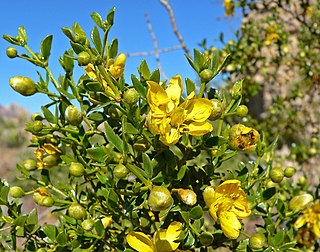
Zygophyllaceae is a family of flowering plants that contains the bean-caper and caltrop. The family includes around 285 species in 22 genera.

Hyacinthus is a small genus of bulbous, spring-blooming perennials. They are fragrant flowering plants in the family Asparagaceae, subfamily Scilloideae and are commonly called hyacinths. The genus is native to the area of the eastern Mediterranean from the south of Turkey to Israel/Palestine, although naturalized more widely.

Delphinium is a genus of about 300 species of annual and perennial flowering plants in the family Ranunculaceae, native throughout the Northern Hemisphere and also on the high mountains of tropical Africa. The genus was erected by Carl Linnaeus.

The Integrated Taxonomic Information System (ITIS) is an American partnership of federal agencies designed to provide consistent and reliable information on the taxonomy of biological species. ITIS was originally formed in 1996 as an interagency group within the US federal government, involving several US federal agencies, and has now become an international body, with Canadian and Mexican government agencies participating. The database draws from a large community of taxonomic experts. Primary content staff are housed at the Smithsonian National Museum of Natural History and IT services are provided by a US Geological Survey facility in Denver. The primary focus of ITIS is North American species, but many biological groups exist worldwide and ITIS collaborates with other agencies to increase its global coverage.
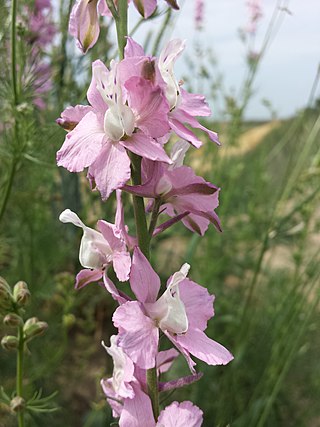
Consolida is a genus of about 40 species of annual flowering plants in the family Ranunculaceae, native to western Europe, the Mediterranean and Asia. Phylogenetic studies show that Consolida is actually an annual clade nested within the genus Delphinium and it has been treated as a synonym of Delphinium in Kew's Plants of the World Online. The name of the genus comes from an archaic use of consolidation, meaning "healing", in reference to the plant's medieval use for healing wounds.
Natural Resources Conservation Service (NRCS), formerly known as the Soil Conservation Service (SCS), is an agency of the United States Department of Agriculture (USDA) that provides technical assistance to farmers and other private landowners and managers.

Custard apple is a common name for several fruits and may refer to Annonaceae, the custard apple family, which includes the following species referred to as custard apples:
Plants For A Future (PFAF) is an online not for profit resource for those interested in edible and useful plants, with a focus on temperate regions. Named after the phrase "plans for a future" as wordplay, the organization's emphasis is on perennial plants.

Consolida regalis, known as forking larkspur, rocket-larkspur, and field larkspur, is an annual herbaceous plant belonging to the genus Consolida of the buttercup family (Ranunculaceae).
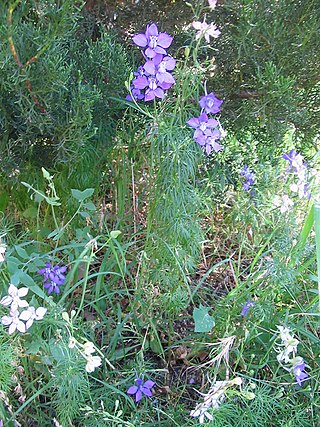
Consolida ajacis is an annual flowering plant of the family Ranunculaceae native to Eurasia. It is widespread in other areas, including much of North America, where it is an introduced species. It is frequently grown in gardens as an ornamental for its spikes of blue, pink or white flowers. It may reach a meter in height. Since the aerial parts and seeds of C. ajacis have been found to contain diterpenoid alkaloids, including the highly toxic methyllycaconitine, the plants should be considered as poisonous.
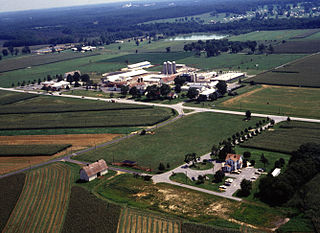
The Henry A. Wallace Beltsville Agricultural Research Center (BARC), also known as the National Agricultural Research Center, is a unit of the United States Department of Agriculture's Agricultural Research Service. It is located in unincorporated Prince George's County, Maryland, with sections within the Beltsville census-designated place. The BARC is named for Henry A. Wallace, former United States vice president and secretary of agriculture. BARC houses the Abraham Lincoln Building of the National Agricultural Library.
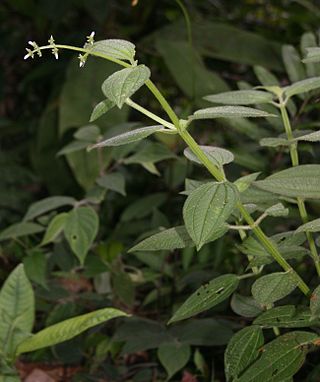
Aciotis is a genus of flowering plants in the family Melastomataceae. There are about 13 species distributed from Mexico to Brazil.
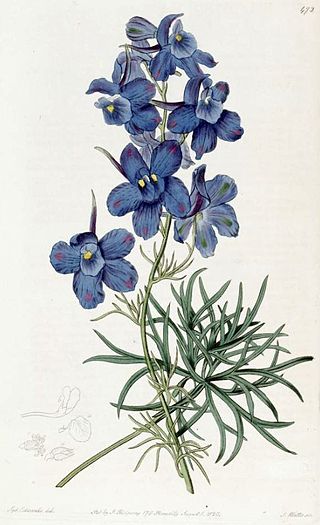
Delphinium grandiflorum is a species of Delphinium known by the common names Siberian larkspur and Chinese Delphinium. It is native to Russia and China. There are several popular cultivars in several colours which are grown as ornamental plants, including 'Blue Butterfly', 'Summer Morning', 'Blue Mirror', and 'Summer Stars'. Like many other larkspurs, this plant is poisonous. It is much shorter and more compact than the more familiar tall D. elatum, with dispersed flowers, rather than single spikes.

Trifolin is a chemical compound. It is the kaempferol 3-galactoside. It can be found in Camptotheca acuminata, in Euphorbia condylocarpa or in Consolida oliveriana.
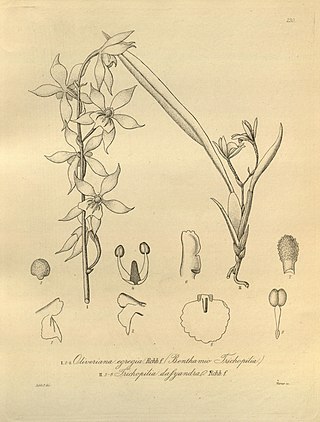
Oliveriana is a genus of flowering plants from the orchid family, Orchidaceae. It contains 6 known species, all native to South America.
- Oliveriana brevilabia(C.Schweinf.) Dressler & N.H.Williams - Peru, Ecuador
- Oliveriana ecuadorensisDodson - Ecuador, Venezuela
- Oliveriana egregiaRchb.f. - Colombia, Guyana
- Oliveriana lehmanniiGaray - Colombia
- Oliveriana ortiziiA.Fernández - Colombia
- Oliveriana simulansDodson & R.Vásquez - Bolivia
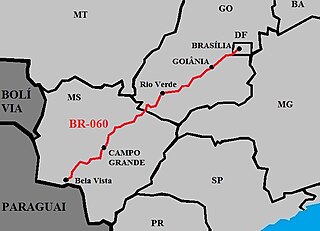
BR-060 is a federal highway of Brazil. The 1329 kilometre road connects Brasília to Bela Vista, on the Paraguayan border.

Gigactonine is a naturally occurring diterpene alkaloid first isolated from Aconitum gigas. It occurs widely in the Ranunculaceae plant family. The polycyclic ring system of this chemical compound contains nineteen carbon atoms and one nitrogen atom, which is the same as in aconitine and this is reflected in its preferred IUPAC name.
Aciotis oliveriana is a plant species native to Colombia, Venezuela, Brazil, Ecuador and Perú. It occurs in disturbed habitats such as river banks, the edges of forests at elevations less than 1350 m.
Synaptolepis is a genus of flowering plants belonging to the family Thymelaeaceae.















